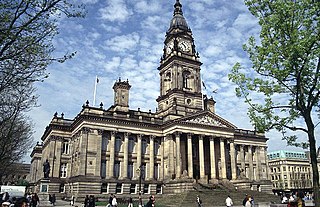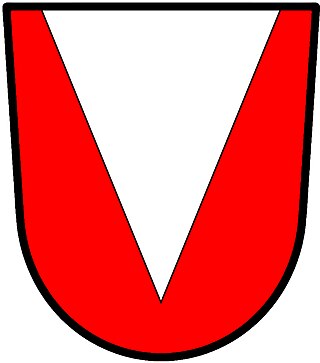
In heraldry, an ordinary is a one of the two main types of charges, beside the mobile charges. An ordinary is a simple geometrical figure, bounded by straight lines and running from side to side or top to bottom of the shield. There are also some geometric charges known as subordinaries, which have been given lesser status by some heraldic writers, though most have been in use as long as the traditional ordinaries. Diminutives of ordinaries and some subordinaries are charges of the same shape, though thinner. Most of the ordinaries are theoretically said to occupy one-third of the shield; but this is rarely observed in practice, except when the ordinary is the only charge.

The coat of arms of Sunderland is the official heraldic arms of the City of Sunderland.

Bromley was a local government district in northwest Kent from 1867 to 1965 around the town of Bromley. The area was suburban to London, and formed part of the Metropolitan Police District and from 1933 was included in the area of the London Passenger Transport Board.

Edmonton was a local government district in north-east Middlesex, England, from 1850 to 1965.

Rhondda was a local government district in the geographical area of the Rhondda Valley, south Wales, from 1877 until 1996, with various statuses through its history.

Salford was, from 1844 to 1974, a local government district in the county of Lancashire in the northwest of England, covering the city of Salford. It was granted city status in 1926.

Oldham was, from 1849 to 1974, a local government district in the northwest of England coterminous with the town of Oldham.

Sale was, from 1867 to 1974, a district in Cheshire, England. The district had in turn the status of local government district, urban district and municipal borough. Its area now forms part of the Metropolitan Borough of Trafford, Greater Manchester.

The Coat of arms of Huddersfield was the official symbol of the local government of Huddersfield. The borough was abolished in 1974, 106 years after its incorporation in 1868, under the provisions of the Local Government Act 1972 whereby control was ceded to Kirklees Metropolitan Council and West Yorkshire Metropolitan County Council.

The Coat of Arms of Bradford City Council was granted in 1976. The present City of Bradford was created in 1974 by the Local Government Act 1972 and is one of five metropolitan boroughs of West Yorkshire. The 1976 arms are based on those of its predecessor, the county borough of Bradford.

The coat of arms of Wigan Metropolitan Borough Council was granted by the College of Arms in 1974.

Stockport County Borough was created by the Municipal Corporations Act 1835 when the existing Borough of Stockport was reformed as a municipal borough. Until 1835 the town was governed by a charter dating from circa 1220 granted by Ranulph de Blondeville, 4th Earl of Chester. The municipal borough consisted of parts of Cheshire, namely the township of Stockport and the neighbouring areas of Edgeley and Portwood and part of Heaton Norris in Lancashire.

Stretford was, from 1868 to 1974, a local government district coterminate with the town of Stretford, Lancashire, England.

Bolton was, from 1838 to 1974, a local government district in the northwest of England conterminate with the town of Bolton.

Rochdale was, from 1856 to 1974, a local government district coterminate with the town of Rochdale in the northwest of England.

Bury was a local government district centred on Bury in the northwest of England from 1846 to 1974.

The Municipal Borough of Heywood was, from 1881 to 1974, a local government district in the administrative county of Lancashire, England, with borough status and coterminate with the town of Heywood.

In heraldry, a pile is a charge usually counted as one of the ordinaries. It consists of a wedge emerging from the upper edge of the shield and converging to a point near the base. If it touches the base, it is blazoned throughout.

Carlisle was, from 1835 to 1974, a local government district in the northwest of England, coterminate with Carlisle. In 1835, following the Municipal Corporations Act 1835, Carlisle was constituted a municipal borough of Cumberland, but was promoted to county borough status in 1914, within its boundaries taking over the functions of Cumberland County Council. The district was abolished on 31 March 1974 by the Local Government Act 1972.

Teesside was, from 1968 to 1974, a local government district in northern England. It comprised a conurbation that spanned both sides of the River Tees from which it took its name. Teesside had the status of a county borough and was independent of the county councils of the North Riding of Yorkshire, and County Durham. The Lord Lieutenant of the North Riding of Yorkshire represented the whole of Teesside, including those areas north of the Tees which were in Durham.




















